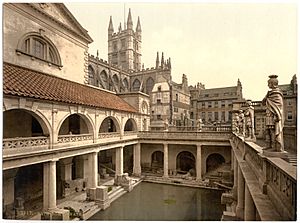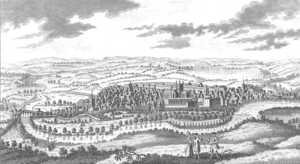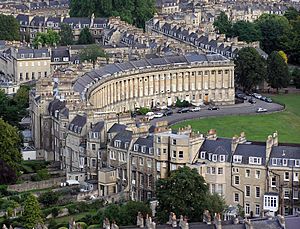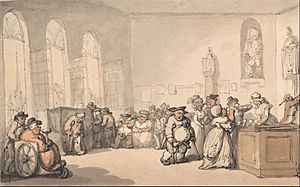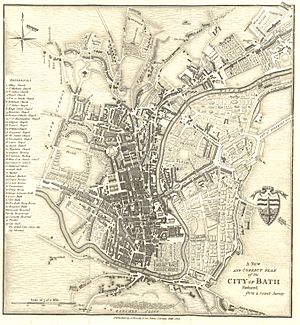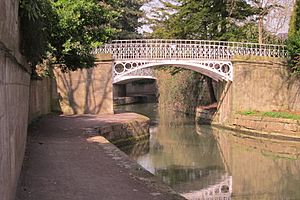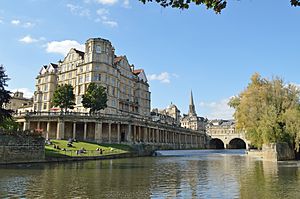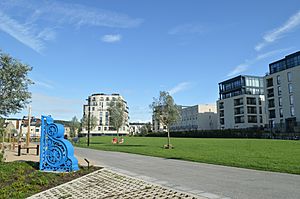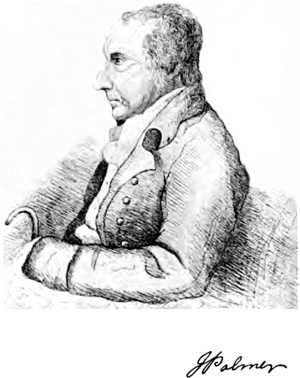Timeline of Bath, Somerset facts for kids
The city of Bath, located in Somerset, England, has a long and interesting history. People have lived here for thousands of years, drawn by its natural hot springs. This timeline explores the key events that shaped Bath, from ancient times to the present day.
Ancient Times: Prehistory to Roman Rule
- Mesolithic Period: Humans were active on Bathampton Down, showing early signs of life in the area.
- Iron Age: A hillfort was built on Bathampton Down, likely for defense.
- 863 BC (Legend): The story goes that King Bladud discovered the special hot springs of Bath.
Roman Bath: Aquae Sulis
- Around 60s AD: The first Roman temple structures were built around the hot springs. They were finished by 76 AD.
- 2nd Century:
- Early in the century, the Roman baths were made bigger.
- Later, the baths were covered with arched roofs.
- 3rd Century: City walls were built around Bath for protection.
- 300–350 AD: There is evidence that Christians lived in Bath during this time.
- 5th Century: After the Romans left Britain, Bath was mostly abandoned.
Early Middle Ages: Saxon and Norman Times
- 516: The Battle of Badon took place, a famous fight against the Saxons. Some say a leader connected to King Arthur won this battle, possibly on Bathampton Down.
- 577: At the Battle of Deorham, the Saxons captured Bath. The city then became part of the Saxon kingdom of the Hwicce.
- 628: After the Battle of Cirencester, the Hwicce kingdom came under the rule of Mercia.
- 676: Abbess Berta started a convent with the help of Osric, King of the Hwicce.
- 757: Cynewulf of Wessex gave land in Bath to monks of St Peter.
- 781: Offa of Mercia took control of the monastery from the Bishop of Worcester.
- 878: Bath became a royal town (a "burh") under Alfred the Great, part of his kingdom of Wessex and the county of Somerset.
- Around 900: A market was active in Bath.
- 973: On May 11, Edgar the Peaceful, King of England, was crowned at Bath Abbey. The Church of St Swithin, Walcot, was also founded around this time.
- Around 980: Ælfheah became the abbot of Bath.
Medieval and Tudor Times: 11th to 17th Centuries
- 1087: The town, Abbey, and mint were given to John of Tours.
- 1090: John of Tours, who was the Bishop of Wells, moved his main church to Bath. This gave Bath its city status.
- Early 12th Century: The King's Bath was built.
- 1102: A fair was active in Bath.
- 1137: A major fire damaged the city.
- 1148–1161: The Abbey was officially opened sometime between these years.
- Around 1174: St John's Hospital was founded.
- 1273: The Old Bridge was already in use.
- 1285: The Church of St Michael's Within was built inside St John's Hospital.
- Around 1333: Monks from the Abbey started a weaving business in Broad Street.
- 1371: A market was mentioned in a royal document.
- Around 1435: The Hospital of St Catherine was established.
- 1482: "Sally Lunn's House" was built.
- Around 1495: St Mary Magdalen, Holloway, was built as a chapel for a hospital for people with leprosy.
- 1499: Bishop Oliver King found the Abbey in ruins and began rebuilding it.
- 1533: The rebuilding of the Abbey was mostly finished.
- 1539: In January, the Abbey was given up during the Dissolution of the Monasteries.
- 1552:
- King Edward's School was founded as a grammar school.
- The first market house was built around this time.
- 1572:
- The Abbey, which had no roof, was given to Bath's leaders to restore as a church.
- Dr. John Jones was the first to publicly say that the city's water had medicinal benefits.
- 1576: The Queen's Bath was built.
- 1578: A drinking fountain was put in the Baths.
- 1590: Queen Elizabeth I officially granted Bath its city status.
- 1597: Poor people were allowed to use the mineral water for free.
- 1608: Bellott's Hospital was established.
- 1613 and 1615: Anne of Denmark, wife of King James I, visited Bath for her health.
- 1616: The Abbey Church was officially opened.
- 1625–1628: The Guildhall was rebuilt.
- 1643: On July 5, the Battle of Lansdowne was fought near the city.
- 1657: Regular coach service started from London to Bath.
- 1676: Dr. Thomas Guidott published the first book about the medicinal properties of Bath's water.
- 1677: The West Gate pub opened for business.
- 1680: The famous Sally Lunn bun is thought to have originated around this time.
- 1687: Mary of Modena, Queen of England, visited hoping the Bath waters would help her have a baby. She became pregnant later that year.
Georgian Era: 1700s
- 1702–1703: Queen Anne visited Bath.
- 1704: The first pump-room was built. Richard "Beau" Nash became the Master of Ceremonies, organizing social events.
- 1705: The first theatre in the city was built.
- 1707: The Bath Turnpike Trust was set up to manage roads.
- 1708: Harrison's Assembly Rooms, with a riverside walk, opened.
- 1711: The Bluecoat school was founded as a charity.
- 1712: In March, Ralph Allen was appointed postmaster.
- 1715: The Church of St Michael's Within was rebuilt by William Killigrew.
- 1720: Ralph Allen began managing postal services in the southwest of England.
- 1721: The Bluecoat school opened.
- 1724: James Leake, a bookseller, opened his business.
- 1725–1727: The Guildhall was made larger.
- 1725:
- John Wood the Elder returned to Bath and shared his plans for the city with Ralph Allen.
- William Oliver, a doctor, settled in Bath around this time.
- 1726:
- Ralph Allen started buying stone from Combe Down and Bathampton Down Mines for building.
- James Brydges, Duke of Chandos, bought Chandos House to rent out rooms.
- 1727–1728: John Wood the Elder built a new building for St John's Hospital.
- 1727–1736: Beaufort Square was designed by John Strahan.
- 1727:
- A gilt bronze head from a Roman statue of Sulis Minerva was found by workers and placed in the guildhall.
- On December 15, the River Avon was made navigable downstream to Bristol.
- Construction of Ralph Allen's Town House began around this time.
- 1728:
- St John's Gate ("Trim Bridge") was built.
- The first Bath Racecourse was recorded.
- 1728–1736: Queen Square was designed by John Wood the Elder.
- 1730s: Parade Gardens were laid out.
- 1731: A special track was opened to carry building stone from Ralph Allen's Combe Down mine to the Kennet and Avon Canal.
- Around 1733:
- Thomas Warr Attwood became the first Bath City Surveyor and Architect.
- The first printing press was set up in the city by Felix Farley.
- 1734:
- William IV, Prince of Orange, visited, marked by an obelisk built in 1735.
- Construction began on Ralph Allen's house at Prior Park, designed by John Wood the Elder.
- On December 25, St Mary the Virgin, the city's first private chapel, opened.
- 1735:
- Construction of New Bridge began to carry the Bristol Road over the Avon.
- Gay Street was laid out by John Wood the Elder.
- 1738: Frederick, Prince of Wales, and Princess Augusta visited, and an obelisk was put up in Queen Square.
- 1739:
- The Royal National Hospital for Rheumatic Diseases (Royal Mineral Water Hospital) was established.
- Portrait painter William Hoare settled in Bath.
- Around 1741: North Parade was built by John Wood the Elder.
- 1742:
- Ralph Allen was elected mayor, and his home at Prior Park was finished.
- The Church of St Swithin, Walcot, was rebuilt after storm damage.
- William Frederick, a bookseller, opened his business.
- 1743–1749: South Parade was built by John Wood the Elder.
- 1744:
- On February 27, the Bath Journal, the city's first newspaper, began publication.
- A "sham bridge" was designed by Alexander Pope in Ralph Allen's Prior Park Landscape Garden.
- 1745: Beau Nash had to retire as Master of Ceremonies because of new anti-gambling laws.
- 1747: The Bath Pauper Scheme began to help the poor.
- 1750:
- On October 27, the Old Orchard Street Theatre opened.
- The Bath Oliver biscuit was created by Dr. William Oliver around this time.
- 1751: The Pump Room was made larger, cutting into the King's Bath.
- 1752: King Edward's School was rebuilt in Broad Street.
- 1754:
- In February, construction of The Circus houses began, designed by John Wood the Elder.
- The Old Bridge was rebuilt.
- 1754–1755: The North and South Gates were pulled down.
- 1755:
- The Bath Advertiser newspaper began publication.
- The Roman Bath was rediscovered.
- Kingston Baths were built for the Duke of Kingston-upon-Hull.
- A Palladian bridge was built in Prior Park Landscape Garden.
- 1758–1774: Portrait painter Thomas Gainsborough lived at 17 The Circus.
- 1759: William Pitt, a government official, ordered James Wolfe to capture Quebec City from his home at 7 The Circus.
- 1760: Gay Street was further developed.
- 1762: A "sham castle" was built as a decorative feature in Prior Park Landscape Garden.
- 1762–1763: Milsom Street was built.
- 1765: On October 6, the second chapel of the Countess of Huntingdon's Connexion opened.
- 1766:
- Christopher Anstey published his funny poem The New Bath Guide.
- Astronomer William Herschel arrived in Bath. His house in New King Street was built.
- On December 20, construction of the Royal Crescent houses began, designed by John Wood the Younger.
- 1767–1768: Brock Street was built by John Wood the Younger.
- 1768: The Theatre Royal, Bath, and Theatre Royal, Norwich, became official "Royal" theatres.
- 1769: The Circus houses were completed by John Wood the Younger.
- 1769–1774: Pulteney Bridge was built, designed by Robert Adam.
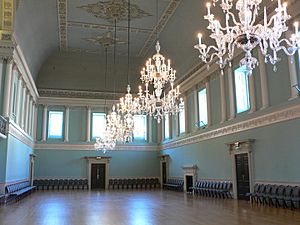
The Bath Assembly Rooms.
- 1771: On September 30, the new Upper Assembly Rooms opened.
- 1772: On March 18, playwright Richard Brinsley Sheridan ran away with singer Elizabeth Ann Linley from her home in Royal Crescent.
- 1774: The Royal Crescent houses were completed.
- 1775–1777: The Hot Bath was built by John Wood the Younger.
- 1775: On November 15, architect Thomas Warr Attwood died. Thomas Baldwin became the new City Surveyor.
- 1777–1779: A Wesleyan church was built in New King Street.
- 1777:
- On August 28, the Society for the Encouragement of Agriculture, Arts, Manufactures, and Commerce was founded.
- The Church of St Swithin, Walcot, reopened after being rebuilt.
- A card room was added to the Assembly Rooms.
- A real tennis court opened in Julian Road.
- 1778–1782: Actress Sarah Siddons performed at the Old Orchard Street Theatre.
- 1778: The new Guildhall was finished, and the old one was pulled down.
- 1779: On December 28, the Bath Philosophical Society was founded.
- 1780:
- On June 13, there was anti-Catholic unrest.
- The Roman Great Bath was rediscovered.
- The Sally Lunn bun was first recorded.
- Oxford Row was built around this time.
- 1781: On March 13, William Herschel discovered the planet Uranus from his garden in New King Street.
- 1783–1784: The Cross Bath was built by Thomas Baldwin.
- 1784: On August 2, John Palmer showed off his mail coach system.
- 1787–1788: Camden Crescent was built by John Eveleigh.
- 1788–1794: Laura Place was built by Thomas Baldwin and John Eveleigh.
- 1788: The Bath Casualty Hospital opened.
- 1789–1793: Lansdown Crescent was built by John Palmer.
- 1789:
- In July, the Bath Improvement Act was passed, giving the city council powers to rebuild.
- The South Colonnade for the Grand Pump Room was completed.
- A Congregational church opened in Argyle Street.
- 1790:
- On April 9, Thomas Baldwin was appointed the first architect for the Improvement Commissioners.
- The North Colonnade for the Grand Pump Room was completed.
- A Roman temple pediment was found near the Baths.
- Construction of Somerset Place began.
- 1791: On March 31, construction of Bath Street began.
- 1792:
- In March, construction of Norfolk Crescent began.
- The Bath City Dispensary and Infirmary was founded.
- Races began at the Lansdown Course.
- 1793:
- In September, Sydney Gardens began to be laid out.
- There was a bank crash in Bath.
- 1795:
- On May 11, Sydney Gardens opened as pleasure grounds. The Sydney Hotel was being built there.
- On December 28, the Grand Pump Room opened.
- The Harmonic Society was formed.
- 1796: York Street opened.
- 1797–1798: The Cross Bath was rebuilt by John Palmer.
- 1797:
- On May 30, William Wilberforce, who fought against slavery, married Barbara Spooner in Bath.
- The House of Antiquities opened to show old finds.
- 1798: On November 7, Christ Church was opened.
- 1799:
- By summer, William Smith created the first large-scale geological map of the Bath area.
- On August 8, lace went missing from a shop, and Jane Leigh Perrot (Jane Austen's aunt) was charged with theft.
- On December 11, William Smith drew up a table of rock layers around Bath.
- The Sydney Hotel opened in Sydney Gardens.
- A new Philosophical Society was started.
Victorian and Edwardian Eras: 1800s and Early 1900s
- 1800:
- The north side of Pulteney Bridge collapsed in a flood.
- S. W. Simms, a bookseller, opened his business.
- A Jewish community was formed.
- The first houses in Sydney Place were completed.
- 1801:
- In January, Jane Austen moved to Bath when her father retired. She lived mostly in Sydney Place.
- On May 1, the Kennet and Avon Canal opened from Bath to Devizes.
- 1802: Hot air balloon ascents took place from Sydney Gardens.
- 1805:
- On January 1, Jane Austen's father died in Bath.
- A penitentiary (a prison) was established.
- The new Theatre Royal opened.
- De Montalt Mill was set up as a paper mill.
- 1806: The east wing of the Grand Pump Room was completed.
- 1808: New houses in Sydney Place were completed.
- 1810:
- Lancasterian Free School was established.
- Union Street was completed.
- 1812: The Jewish Burial Ground in Combe Down opened.
- 1813: Claverton Pumping Station opened, helping to keep the canal locks working.
- 1815:
- Cleveland Pools opened.
- Stothert's iron foundry was established.
- 1816: On January 8, the third Bath Philosophical Society was formed.
- 1817:
- Queen Charlotte visited.
- Atkinson & Tucker, booksellers, opened their business.
- 1818: Bath Gas Light Company was established.
- 1819: The Masonic Hall was dedicated.
- 1821: On February 6, the original Assembly Rooms were destroyed by fire.
- 1822:
- Norfolk Crescent was completed.
- A post office opened in Broad Street.
- 1824: The Bath Royal Literary and Scientific Institution was founded.
- 1825:
- On January 19, the Bath Royal Literary and Scientific Institution opened its building.
- The Corridor, one of the world's first shopping arcades, was built.
- The Mechanics Institute opened.
- Lansdown Cricket Club was formed.
- 1826:
- Bath United Hospital opened.
- A. H. Hale's pharmacy opened in Argyle Street.
- 1827:
- Beckford's Tower was completed for William Beckford.
- Cleveland Bridge opened as a toll bridge.
- John Loudon McAdam became Surveyor of the Bath Roads.
- Partis College was completed as almshouses for women.
- 1829: A new basin at the baths was completed.
- 1830:
- Victoria Park was opened by the 11-year-old Princess Victoria.
- Prior Park College opened.
- 1831: Jolly's department store opened.
- 1832: Sydney Buildings were constructed.
- 1833–1834: George Phillips Manners restored the Abbey.
- 1834–1837: St Michael's Without church was rebuilt.
- 1834: Stothert, Rayne & Pitt acquired the Newark Iron Foundry.
- 1836:
- On January 1, local government was reformed.
- On March 28, the Bath Poor Law Union was formed.
- On May 30, a major fire occurred at Prior Park.
- North Parade Bridge and Victoria suspension bridge were built.
- 1837: The Victoria Column was put up in Royal Victoria Park.
- 1839: Isaac Pitman moved to Bath.
- 1840:
- On May 2, the first Penny Black postage stamp was sent from Bath.
- On June 6, novelist Fanny Burney died in Bath.
- On August 31, the Great Western Railway opened from Bath to Bristol.
- 1841:
- In January, there were major floods.
- In November, the first photographic studio opened in Bath.
- 1846: The city was allowed to get drinking water from springs at Bathampton and Batheaston.
- 1847: Commercial Reading Room and Tottenham Library were founded.
- 1851: Kingswood School moved to Bath.
- 1852: Bath School of Art was founded.
- 1854: A Post Office opened in York Buildings.
- 1855:
- In February, the Bath Natural History and Antiquarian Field Club was established.
- The Bath Quartet Society was established.
- A corn market was built in Walcot Street.
- 1856: J. B. Bowler, an engineer and drink maker, opened his business.
- 1859–1860: A new Bluecoat school was built.
- 1861–1863: St John the Evangelist Roman Catholic Church was built.
- 1861: Guildhall Market was built.
- 1862: On April 18, a major fire caused the Theatre Royal to be rebuilt.
- 1863: Widcombe footbridge was first built over the Avon in wood.
- 1864:
- Bath United Hospital was given its "Royal" title.
- Locksbrook Cemetery opened.
- 1865:
- Bath Rugby was founded.
- The Old Orchard Street Theatre became a Masonic Hall.
- 1867:
- Alexander Graham Bell set up a telegraph line in Bennett Street.
- James Irvine recorded remains of the Roman temple of Sulis Minerva.
- 1869–1885: Excavations of the Roman Baths were carried out by Maj. C. E. Davis.
- 1869:
- On August 4, Queen Square station opened for passengers.
- The original White Horse Inn was pulled down.
- 1870–1873: St Andrew's Church was built.
- 1874:
- On July 20, the Somerset and Dorset Railway began operating from Queen Square station.
- The Manvers Estate was sold.
- 1875:
- Bath High School for Girls was established.
- Bath City Police was established.
- 1877: On June 6, Widcombe footbridge collapsed, killing eleven people. It was rebuilt.
- 1878:
- Bath College opened.
- The Corporation acquired Kingston Baths.
- 1880:
- On February 28, Bath Golf Club was founded.
- On December 24, the Bath Tramways Company began operating horse-drawn trams.
- 1881: The population was 52,557.
- 1882: The Holburne Museum art collection was given to the city.
- 1883: The Queen's Bath was mostly pulled down, revealing a Roman circular bath.
- 1886: The first telephone exchange opened.
- 1887: Botanical Gardens opened in Royal Victoria Park.
- 1888: Bath Photographic Society was formed.
- 1889:
- On April 1, Bath became a county borough.
- On June 21, William Friese-Greene patented an early movie camera.
- New baths were completed, designed by C. E. Davis.
- A landslide destroyed nine houses in Camden Crescent.
- Twerton Co-operative Society opened its first shop.
- Bath Association Football Club was formed.
- 1890: An electricity generating station began operating.
- 1891: Bath Fire Brigade and Ambulance Service was established.
- 1892: Technical training began, leading to the City of Bath Technical School.
- 1893: The Holburne Museum opened in Charlotte Street.
- 1894: Major floods occurred.
- 1896: In April, Bath Municipal Technical College and Bath City Secondary School were established.
- 1897:
- On October 18, the Victoria Art Gallery foundation stone was laid.
- Henrietta Gardens were laid out.
- The Roman Baths and Concert Room opened to the public.
20th Century: Modern Bath
- 1900:
- Silcox Son & Wicks, furnishers, was established.
- In May, the Victoria Art Gallery and Reference Library opened.
- New houses for working-class families were built in Dolemeads.
- 1901:
- The Empire Hotel opened.
- The population was 49,839.
- 1902: On July 25, the horse tram system closed for electrification.
- 1904: On January 2, the Bath Electric Tramways Company began operating.
- 1905: On December 12, Midland Bridge opened.
- 1907: Bath School of Pharmacy was established.
- 1909:
- The Old Bath Preservation Society was set up.
- A Historical Pageant was held in Royal Victoria Park.
- St Winifred's Quarry was built as a house.
- 1910: Jubilee Hall Cinema operated in the Assembly Rooms.
- 1911: On November 9, Twerton and parts of Charlcombe and Weston were added to the city boundary.
- 1915:
- T. R. Hayes, furnishers, was established.
- In December, Robert Atkinson was asked to create a post-war plan for the city.
- 1916:
- Bath War Hospital was set up.
- The Holburne Museum moved to the former Sydney Hotel.
- 1920: Bath Tramways Motor Company was set up to run buses.
- 1923:
- Roman hot plunge baths were excavated.
- Kingston Baths were demolished.
- 1925:
- The Bath Corporation Act included powers for conservation.
- Lansdown Water Tower was built.
- 1927:
- On May 16, the new Post Office and Telephone Exchange opened.
- On November 3, the City war memorial was dedicated.
- 1929:
- On June 20, Cleveland Bridge became toll-free.
- In July, the Roman Catholic Church of Our Lady & St Alphege was completed.
- 1931: In October, the Assembly Rooms were bought by the Society for the Protection of Ancient Buildings and given to the National Trust for restoration.
- 1932:
- The Bath Royal Literary and Scientific Institution moved to Queen Square.
- On December 11, the Royal United Hospital opened.
- 1934: The Bath Preservation Trust was founded.
- 1936–1941: Haile Selassie, the deposed Emperor of Ethiopia, lived in Bath during his exile.
- 1936: North Parade Bridge was rebuilt.
- 1937:
- The Bath Corporation Act included more conservation powers.
- A school crossing patrol ("lollipop lady") was appointed, one of the first in the UK.
- 1938:
- On October 15, the Assembly Rooms reopened after restoration.
- Kilowatt House, a unique modern house, was completed.
- 1939:
- On May 6, the last tram routes in Bath were converted to motor bus operation.
- On September 3, at the start of World War II, parts of the British Admiralty moved to Bath.
- 1942: On April 25–27, the Bath Blitz occurred. German bombing raids killed 417 people and destroyed or damaged many buildings, including the Assembly Rooms.
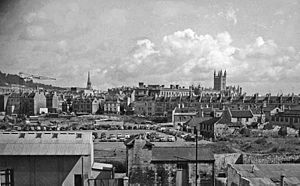
Bath city centre in 1958, still showing signs of the Bath Blitz damage.
- 1944: From March to November, John Betjeman worked on publicity for the Admiralty at the Empire Hotel.
- 1945: Town planner Patrick Abercrombie created "A Plan for Bath" for post-war rebuilding.
- 1946: In October, the City of Bath Bach Choir was founded.
- 1948:
- The Bath Assembly (music festival) began.
- Queen Square was given to the citizens of Bath in memory of those killed in the Blitz.
- 1951: George Perry-Smith opened the innovative Hole in the Wall restaurant.
- 1955:
- The Bath Terraces Scheme was introduced to protect the city's old buildings.
- A covered reservoir opened on Bathampton Down.
- 1958: A bus station opened in Manvers Street.
- 1960: In December, major floods occurred.
- 1961: Bath Crematorium opened.
- 1963:
- On May 23, the Assembly Rooms reopened after post-war rebuilding, including the Museum of Costume.
- On June 10, The Beatles played at the Pavilion.
- 1965–Easter 1983: Excavations of the Roman Baths took place under Barry Cunliffe.
- 1965: Town planner Colin Buchanan published "Bath: a planning and transport study."
- 1966:
- On March 7, Bath Green Park railway station closed.
- In November, the University of Bath was officially recognized.
- Churchill Bridge replaced the Old Bridge.
- The electricity generating station stopped operating.
- 1969–1972: The original Southgate Shopping Centre was built.
- 1969: J. B. Bowler's business closed.
- 1970:
- On May 16, Widcombe bottom lock reopened as part of the Kennet and Avon Canal restoration.
- In June, the Bath Festival of Blues and Progressive Music was held.
- On June 20, No. 1 Royal Crescent opened to the public as a museum.
- From September 23–29, Adam Fergusson's essay "The Sack of Bath" criticized inappropriate development.
- 1971:
- On April 25, the population was 84,670.
- A new semicircular Pulteney Weir was completed in the Avon.
- Bath gasworks stopped production.
- 1973: On March 30, the Beaufort Hotel opened.
- 1974:
- On April 1, Bath became part of Avon county.
- On December 9, an Irish Republican Army bomb exploded in The Corridor.
- 1975:
- Bath College of Higher Education was established.
- The Hermann Miller furniture factory was built.
- 1978: Spa baths closed due to contamination.
- 1979:
- On April 27, the Bath Postal Museum opened.
- Roper Rhodes bathroom accessories business was launched.
- 1981: The Bath Fringe Festival and Bath Half Marathon began.
- 1986:
- On July 26, a major fire occurred at The Colonnades.
- The Bristol and Bath Railway Path was laid out.
- 1987:
- On May 22, GWR FM Bath, a local radio station, launched.
- In December, the City of Bath was named a World Heritage Site.
- 1989: On January 11, the closure of Stothert & Pitt was announced.
- 1991:
- On April 21, the population was 78,689.
- In summer, a major fire occurred at Prior Park.
- 1993:
- In April, the Museum of East Asian Art opened.
- In May, the Bath Royal Literary and Scientific Institution was relaunched. A new public library opened.
- 1995: The Bath Literature Festival began.
- 1996: On April 1, the city became part of the Bath and North East Somerset district.
- 1997: The Ustinov Studio (theatre) was built.
- 1999: On November 15, Bath FM, another local radio station, launched.
21st Century: Bath Today
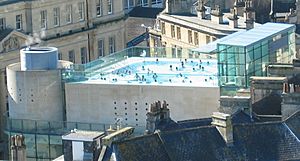
The rooftop pool at Thermae Bath Spa.
- 2000: The new Wessex Water headquarters was built on Claverton Down.
- 2001: In April, the city population was 83,992.
- 2002: The Bath Times newspaper began publication.
- 2005:
- In August, Bath Spa University gained full university status.
- In October, The Egg, a theatre, opened.
- 2006: On August 7, the Thermae Bath Spa facility opened.
- 2007:
- In September, the Bath Festival of Children's Literature began.
- In October, the Bath Chronicle newspaper changed to weekly publication.
- 2008: The Beau Street Hoard, a collection of Roman coins, was found.
- 2009: The Bath bus station and SouthGate shopping centre opened.
- 2011:
- In April, the population was 88,859.
- In October, Occupy Bath began.
- Construction of the Bath Western Riverside residential area began.
- 2015: In April, City of Bath College was renamed Bath College.
- 2021: In March, a Clean Air Zone was introduced in central Bath.
Famous People Born in Bath
- Around 953: Ælfheah of Canterbury, who became an archbishop.
- Around 1080: Adelard of Bath, a natural philosopher.
- 1704: John Wood the Elder, a famous architect.
- 1707: Benjamin Robins, a military engineer.
- 1728: John Wood the Younger, also a famous architect.
- 1732: David Hartley the Younger, a statesman and inventor.
- Around 1738: John Palmer, an architect.
- 1742: John Palmer, who created the mail coach system.
- 1744: Richard Lovell Edgeworth, a politician, writer, and inventor.
- 1751: Honora Sneyd, an educationalist.
- 1754: Elizabeth Ann Linley, a soprano singer.
- 1771: Frances Brett Hodgkinson, an actress.
- 1773: William Amherst, who became Governor-General of India.
- 1780:
- William Hone, a writer and satirist.
- Daniel Terry, an actor and playwright.
- 1790: William Parry, an Arctic explorer.
- 1794:
- William Lonsdale, a geologist.
- James Dredge the Elder, a civil engineer.
- 1796: John Pinch the Younger, an architect.
- 1807: Robert Montgomery, a poet.
- 1808: Henry Cole, a civil servant and inventor.
- 1810: Edward Vansittart Neale, a Christian socialist.
- 1816: Abraham Marchant, a Mormon leader.
- 1820: Charles Lowder, a priest.
- 1835: William Eden Nesfield, an architect.
- 1840: James Dredge the Younger, a journalist.
- 1846: C. P. Scott, a newspaper editor.
- 1872: Edith Garrud, a pioneer martial artist and suffragist.
- 1880: Thomas Ley, an Australian politician.
- 1881: Sidney Horstmann, an engineer and businessman.
- 1888: Martin D'Arcy, a Catholic intellectual.
- 1896: Arnold Ridley, a playwright and actor.
- 1898: Harry Patch, the last surviving combat soldier of World War I.
- 1901: Caryll Houselander, a Catholic mystic.
- 1903: G. E. Trevelyan, a novelist.
- 1935: Mary Berry, a famous food writer and TV presenter.
- 1943: Jonathan Lynn, a director, producer, writer, and actor.
- 1945: Jacqueline Wilson, a popular children's fiction writer.
- 1947: Ann Widdecombe, a politician.
- 1964: Bill Bailey, a comedian and musician.
- 1973:
- Kris Marshall, an actor.
- Indira Varma, an actress.
- 1974: Princess Claire of Belgium.

All content from Kiddle encyclopedia articles (including the article images and facts) can be freely used under Attribution-ShareAlike license, unless stated otherwise. Cite this article:
Timeline of Bath, Somerset Facts for Kids. Kiddle Encyclopedia.

